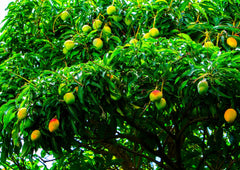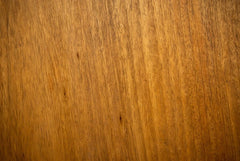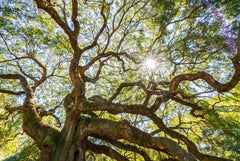Amidst the lush landscapes of tropical regions, the mango tree stands as an emblem of abundance and vitality. Beyond its succulent fruits, this majestic tree gifts us with a material of unparalleled versatility and sustainability: mango wood. In this exploration, we delve deeper into the origins, precise characteristics, and multifaceted benefits of mango wood, shedding light on its scientific substance and eco-friendly allure.
Origins and Characteristics:
-
Botanical Insight:

Mango wood, derived from the beautiful Mange tree also known as the Mangifera indica, which belongs to the Anacardiaceae family. This hardwood species is native to South Asia but has found cultivation in various tropical climates worldwide. The tree's average lifespan ranges from 40 to 100 years, and develop trunk girths of over 4 meters (13 ft). during which it yields an abundant harvest of mango fruits. Once the tree ceases fruit production, its wood becomes available for sustainable harvesting, ensuring minimal environmental impact.
-
Grain Patterns and Colouration:

Mango wood exhibits a remarkable diversity of grain patterns and colour variations, ranging from pale golden hues to rich, dark browns such as our set of 6 wooden tree of life coasters with holder. These characteristics result from the interplay of heartwood and sapwood, with heartwood displaying deeper tones due to natural aging and exposure to environmental factors. Intriguingly, the grain patterns of mango wood can feature straight lines, swirling whirls, or captivating knots, adding an element of natural artistry to each piece.
-
Density and Workability:
Despite its classification as a hardwood, mango wood possesses a moderate density that facilitates ease of workability. Its fine texture allows for precise carving, shaping, and detailing, making it a favored choice among artisans and craftsmen. Furthermore, mango wood displays excellent stability and resistance to warping, cracking, and decay, ensuring longevity in various applications. -
Moisture Resistance and Durability:
Mango wood's inherent resilience extends to its ability to withstand moisture and environmental stresses. Thanks to its naturally occurring resins and oils, mango wood exhibits a degree of water resistance, making it suitable for both indoor and outdoor use. Additionally, its robust nature renders it resistant to pests and fungal decay, contributing to its longevity and low maintenance requirements. -
Environmental Impact:
Beyond its aesthetic and functional attributes, mango wood stands as a testament to sustainable forestry practices. By utilizing wood from mango trees at the end of their fruit-bearing lifecycle, we minimize waste and mitigate the need for deforestation. This eco-conscious approach not only preserves precious ecosystems but also supports local communities reliant on mango cultivation for their livelihoods.
Benefits of Mango Wood:
1. Sustainability:
Mango wood embodies a sustainable alternative to traditional hardwoods, offering a renewable resource that minimises reliance on virgin timber. By repurposing trees at the conclusion of their fruit-bearing cycle, we promote forest regeneration and biodiversity conservation, fostering a harmonious balance between human needs and environmental stewardship.
The growth rate and time to maturity for mango trees and oak trees vary significantly due to differences in species, environmental conditions, and growth habits.
Mango trees (Mangifera indica) typically take around 5 to 8 years to bear fruit after being planted from a seed, or about 3 to 4 years when grown from a grafted sapling. Full maturity, where the tree reaches its maximum size and fruit-bearing capacity, may take 10 to 15 years or more.

In contrast, something like oak trees (genus Quercus) are known for their slow growth and long lifespan. Depending on the species and environmental factors, oak trees can take several decades to reach maturity and begin producing acorns. Generally, oak trees may take anywhere from 20 to 50 years or more to reach maturity, with some species taking even longer.

Overall, mango trees tend to grow and bear fruit at a faster rate compared to oak trees, making them a more feasible option for fruit production in a relatively shorter time frame. Making it a much better, sustainable option to choose if you want to make something, which is good as a lot of our fair trade or ethical artisans.However, interestingly oak trees, with their longevity and ecological importance, play a crucial role in forest ecosystems and provide valuable habitat and resources for wildlife over their extended lifespan. They did a recent study and said the Oak tree is the clear winner with absorbing the most carbon dixoide from the air, so we should definately not cut this tree down.
2. Carbon Sequestration:
As a tree species, mango trees play a vital role in carbon sequestration, absorbing atmospheric carbon dioxide and storing it within their biomass. By utilising mango wood in various applications, we contribute to carbon retention within durable products! Thereby mitigating the impacts of climate change and promoting carbon-neutral lifestyles.
3. Economic Empowerment:

Mango wood production serves as a source of economic empowerment for communities in tropical regions where mango cultivation thrives. Through sustainable forestry practices and value-added processing, local artisans and manufacturers generate income opportunities, supporting livelihoods and fostering socio-economic development.
4. Versatility and Design Appeal:
Mango wood's versatility knows no bounds, spanning an array of applications in furniture, flooring, home decor, and artisanal crafts. Its aesthetic appeal, characterised by warm tones and distinctive grain patterns, lends a touch of natural elegance to any space, transcending trends and enduring through time.
5. Biodegradability and Eco-Friendliness:
In an era marked by heightened environmental consciousness, mango wood emerges as a beacon of eco-friendliness and biodegradability. Unlike synthetic materials, mango wood is inherently organic and non-toxic, posing minimal harm to ecosystems upon disposal. Its natural beauty and earthy allure resonate with consumers seeking sustainable alternatives that align with their values.
Conclusion
In the intricate tapestry of sustainable living and conscious consumption, mango wood stands as a testament to the inherent synergy between nature's bounty and human ingenuity. From its botanical origins to its myriad benefits, mango wood exemplifies the art of harmonizing environmental stewardship with functional elegance. As we embrace the allure of mango wood in our homes, workplaces, and public spaces, let us honor its legacy of sustainability and celebrate its enduring contributions to our collective well-being.
In choosing mango wood, we not only adorn our lives with beauty and functionality but also cultivate a deeper connection to the natural world. So let us cherish the marvels of mango wood and weave its sustainable story into the fabric of our daily lives, one conscientious choice at a time.






















